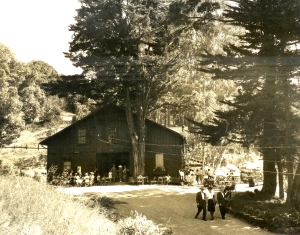by Ray Sikorski

Photo courtesy of Regional Academic Ukrainian Musical and Dramatic Theater
RIVINE, UKRAINE – Rivne, Ukraine, is not the sort of city one imagines when one thinks “theater capital.” Bombed in World War II and occupied by the Nazis, this industrial city of 400,000 has plenty of big Soviet-built apartment blocks, but little in the way of charm. In winter, it can seem downright bleak.
Until one visits the sumptuous Regional Academic Ukrainian Musical and Dramatic Theater, that is. Like the Russian-built Zil limousines that once ferried gangsters and high Communist Party cadres around Soviet cities, the theater flaunts its size and stature. It’s five stories tall: the waiting area has marble floors, high ceilings, and crystal chandeliers; and the seats of its 700-seat proscenium stage are plush red velvet.
My experience in Ukraine, spent mostly in Rivne, was one of contradictions. Antique Lada, Volga, and Muskovitch cars puttered along next to brand new BMW and Lexus SUVs, while antique babushkas shared sidewalk space with statuesque girls in tight pants and calf-hugging stiletto boots. So, in a way, Rivne’s fabulous theater made sense – one of the best theaters in Ukraine, plunked down in a district more reminiscent of Cleveland than the West End or Times Square.
Tatyana Borisovna, an 18-year veteran of Rivne’s stage, now works as manager for the theater’s 45 salaried actors. Borisovna says that it all makes perfect sense, because despite appearances, Rivne is a city of theater lovers. The building actually houses two theaters – there’s an intimate 100-seat theater along with the luxurious proscenium – and barely a night goes by without a sellout performance. And this is with shows going on six nights a week.
Are Ukrainians simply mad about theater? Perhaps. However, with tickets going for a ridiculously cheap 10-30 hryvnia per show (about $1.30-$3.80, and cheaper than a movie), it could just be a good excuse to stay warm. Not so, says Borisovna – the theater puts on lavish, first-rate musical and dramatic performances by Ukrainian and Russian playwrights, with up to 13 different shows per season. People come from the entire region, she says, because the shows are top-rate. I asked her if tough times would keep people away; she said during the 1990’s economic crisis, after the breakup of the Soviet Union, people still came. The theater, she explained, is like a drug, for both actors and audience members – and the people of Rivne are hooked.
But where does the money come from? Certainly not many American performances could be made by charging people a dollar. Borisovna explained that the money people pay for tickets goes to the government, and then the government pays the salaries of everyone involved in the production – there’s a 21-member orchestra, too – who are full-time employees of the theater. Basically, it’s a holdover of the old Soviet system, which put a high value on theater. Among the working people of Rivne, it seems that every day is a struggle to survive; but its actors are well-paid, the theater is well-maintained, and productions are first-class.
One might lead to the conclusion that the people who work in Rivne’s theater are just employees doing a job, and don’t share the same passion for theater that American actors have. After all, private theaters need to sell tickets to keep their doors open. Borisovna says that’s not the case at all. She points to several “legacies” among the actors in the theater, where children – including Borisovna’s own daughter – have taken up the craft after spending countless days after school watching their parents.
“Theater is not just a building,” she says. “It’s a life. Everyone who works in theater loves it; there are no people who don’t. Everyone who works with actors works not just for money.”
(The interview with Tatyana Borisovna was conducted with the translation help of Vova Lypchuk.)
∞
Ray Sikorski wrote and directed his first one-act play in 1988, and his second 20 years later. He is a freelance writer based in Bozeman, Montana, and is currently traveling in Ukraine, wondering if he can find someplace where they sell peanut butter.



